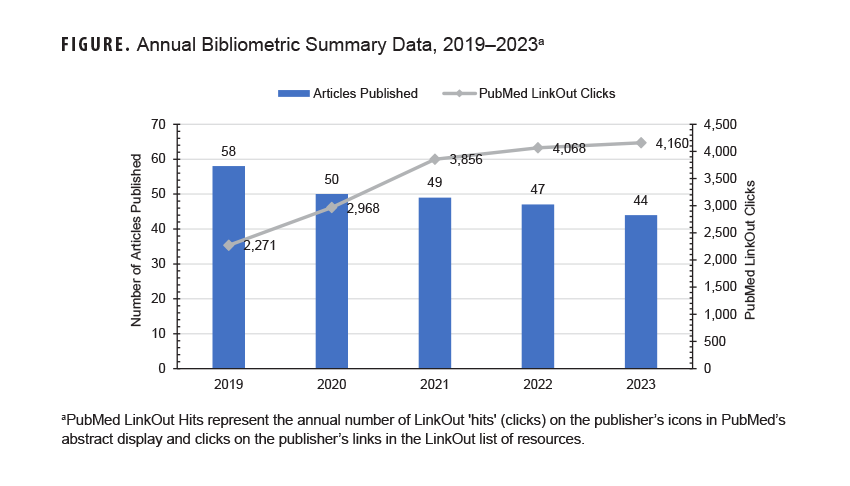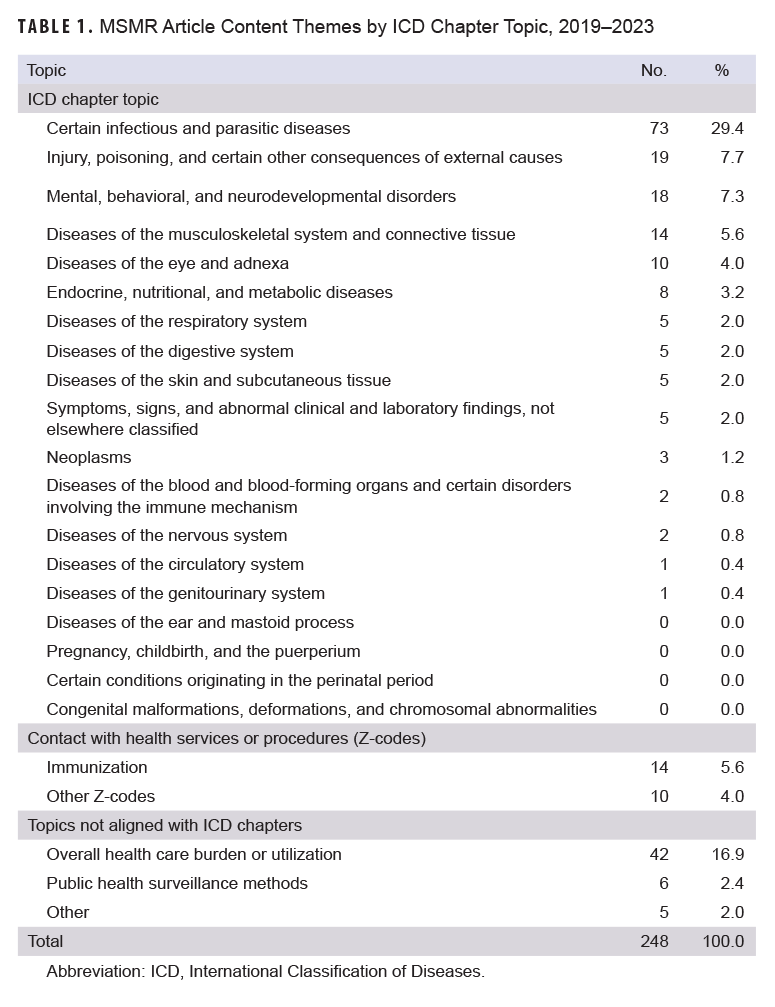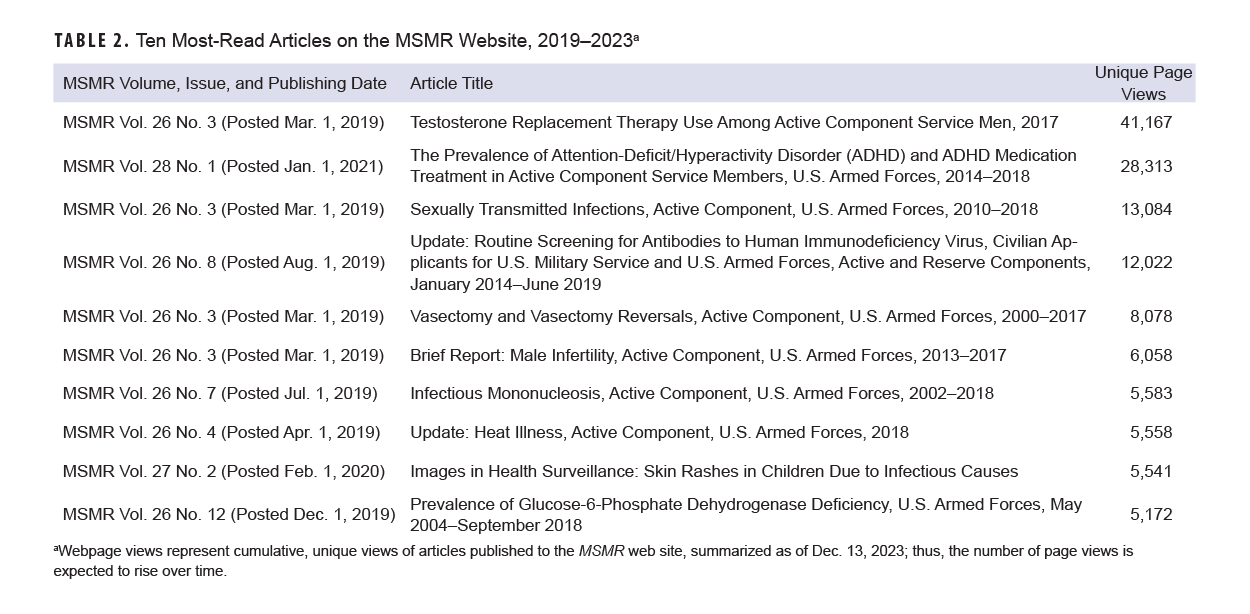In continuous publication since 1995, the Medical Surveillance Monthly Report serves as the official peer-reviewed journal of the Armed Forces Health Surveillance Division and the Defense Health Agency Public Health Directorate. This monthly publication provides evidence-based estimates of the incidence, distribution, impact, and trends of illness and injury among U.S. military service members and associated populations. MSMR reports present data, public health information, and original research with direct relevance to the operational fitness of military members or Military Health System beneficiaries’ health, safety, and well-being.
This editorial provides a bibliometric summary and thematic analysis for articles published in MSMR over a 5-year period, from January 2019 through December 2023. The bibliometric summary provides annual metadata on most-read articles and journal impact, while the thematic content analysis reviews published article data to quantify the populations of focus and primary study outcomes or topics of interest, which are further grouped into major thematic categories, corresponding to the International Classification of Diseases chapter subjects. For analytic summaries described in full and brief reports as well as Surveillance Snapshots, the data sources utilized to study the main outcome were also reviewed.
Summary Data
From January 2019 through December 2023, MSMR published a total of 248 articles. Full reports (n=166), Surveillance Snapshots (n=33), and brief reports (n=17) were the predominant content types, followed by a range of other articles including editorials (n=10), outbreak reports (n=7), case reports (n=6), and historical perspectives (n=5). Less-employed article types included letters to the editor (n=2), notice to readers (n=1), and Images in Health Surveillance (n=1).
The annual number of published articles declined over the past five years, from 58 articles in 2019 to 44 articles in 2023 (Figure). Notably, a summary of Reportable Medical Events for Department of Defense service members and other MHS beneficiaries returned to MSMR in 2023; however, the eight summary reports published in 2023 were not included for this content review. Sentinel RME summaries were regular features of MSMR until 2010.1

The population of interest in the majority of articles (n=206; 83.1%) focused on service members (active component, reserve component, or former service members), while 9.6% (n=24) of articles centered on both service members and non-service member beneficiaries, and 5.6% (n=14) were limited to non-service member beneficiaries; four articles did not include a particular population of interest (e.g., environmental sampling data).

Content Themes
The content themes for each MSMR article published over the 5-year period were reviewed and then grouped into major thematic categories corresponding to ICD chapter subjects. Content themes not aligned to a chapter subject group were classified into separate categories, described in Table 1. Among the 248 total articles published in MSMR from 2019 to 2023, 42 (16.9%) articles provided a summary of total health care burden and provision, rather than one specific thematic topic. Each year, the MSMR publishes an annual compendium of burden of disease reports that groups diagnoses to inform readership of the major drivers of health care provision within the MHS.2
While injuries, musculoskeletal diseases, and mental health disorders are the categories of medical conditions associated with most medical encounters and greatest numbers of hospital bed days reported among active component service members in 2022,2 infectious and parasitic diseases (n=73, 29.4%) represented a substantial majority of publication topics identified in the 5-year content theme review, described in Table 1. Additionally, maternal conditions contributed to approximately 13% of all hospital bed days for active component female service members in 2022,2 but no articles were published for service women on the topics of pregnancy, childbirth, and the puerperium, or for certain conditions originating in the perinatal period.
Publication themes discussing contact with health services or procedures (‘Z-codes’) represented 24 (9.7%) of all articles; the majority of these were related to immunization (n=14, 5.6%) (Table 1). Other topics associated with health service contacts or procedures (n=10, 4.0%) included women’s health issues related to contraception use, infertility, menstrual suppression, or cervical cancer screening (n=5) as well as men’s health issues related to vasectomy or testosterone replacement therapy (n=2) (data not shown).
Data Sources
The methods of each article were manually reviewed to classify the data source of the major outcome of interest that was described in full and brief reports as well as Surveillance Snapshots (n=216). Six data source categories were assessed for each article, including: 1) administrative inpatient and ambulatory records, 2) laboratory results, 3) pharmacy prescriptions, 4) RME records, 5) survey data, and 6) all other data. Many articles included more than one data source for the major outcome of interest, and each of those data sources were classified independently. Since immunization records may be stored in a range of service-specific data systems, or as administrative records, those data were included in the ‘other data’ source category. Data outside of the main outcome of interest that were related to covariate or dependent variable analyses were not assessed.
Almost 30% (n=61) of full and brief reports and Surveillance Snapshots combined more than one data source for analysis of an outcome of interest. Administrative data for clinical conditions from inpatient and ambulatory records, based on ICD diagnoses, contributed to a substantive majority of articles (n=150, 69.4%), followed by laboratory data (n=44, 20.4%), RME records (n=42, 19.4%), then other data sources (n=45, 20.8%). Survey data (n=14, 6.5%) and pharmacy records (n=9, 4.2%) contributed to a smaller proportion of analyses. The largest proportion of other sources from articles with ‘other data’ source classifications included immunization records (n=12), chart reviews (n=8), and medical evacuation records (n=7) (data not shown).
Bibliometric Summary
The articles published to the MSMR website hosted by health.mil garnered a total of 274,518 unique page views from 2019 to 2023, with a median of 296 unique page views per article. Four articles received over 10,000 web page views, with "Testosterone Replacement Therapy Use Among Active Component Service Men" exceeding all other articles during the 5-year period for maximum unique views (n=41,167) (Table 2). The publication date of that article, March 1, 2019, corresponds with a 2018 report from the U.S. Department of Veterans Affairs Office of the Inspector General that documented health care providers’ poor adherence to guideline recommendations for the diagnosis and treatment of men with hypogonadism.3

The National Center for Biotechnology Information LinkOut service routinely tracks the number of clicks from the MSMR publisher icon in PubMed’s abstract listing to the journal’s open access, full text articles on health.mil.4 The LinkOut clicks from MSMR abstracts on PubMed in 2023 remained relatively stable compared to 2022 (Figure), but over the 5-year publication period MSMR’s LinkOut clicks almost doubled, from 2,271 to 4,160. The far greater number of total page views of articles hosted on the MSMR health.mil website compared to LinkOut clicks from PubMed indicates a significant readership originating from the AFHSD journal home page.
MSMR also tracks CiteScore metrics from Scopus, which are based on the number of citations to articles published by a journal over four years, divided by the number of the same document types indexed in Scopus and published during those respective four years.5 The MSMR CiteScore has continually increased over the past three years, from 0.7 in 2020 to 1.9 in 2022.
Future Direction
While MSMR will continue to maintain full text, open access to articles through publication on the journal website in 2024, the full text access from the PubMed abstract display will begin linkage to PubMed Central. This full text archival process will potentially expand readership to a larger academic community, while standardizing and improving historic archival links to PubMed. The journal will also continue to track CiteScore metrics from Scopus. The improvement of the CiteScore metric in recent years corresponds with the increasing number of PubMed LinkOut clicks over the same period, which may be further bolstered by full text archival processes to PubMed Central during 2024.
Biosurveillance remains a high-priority mission for the DOD, with DHA Public Health prioritizing capabilities to support a better biodefense posture in 2023 and beyond.6,7 MSMR welcomes new submissions accordant with the 2023 DOD Biodefense Posture Review, which outlines significant reforms for a resilient force to deter use of bioweapons, rapidly respond to natural outbreaks, and minimize global risk of laboratory accidents.8
Just one-fifth of the analytic reports (i.e., full reports, brief reports, Surveillance Snapshots) published in MSMR from 2019 to 2023 were supported by laboratory capabilities. Critical topics such as antimicrobial resistance, wastewater surveillance, and other environmental threats were presented but are likely under-represented, as sustaining and strengthening U.S. deterrence of the biothreat environment, including naturally occurring, accidental, and deliberate biological threats, is a recently heightened priority.7
A substantial number of articles published from 2019 to 2023 employed dual or multi-sourced data approaches, typically combining laboratory, RME, or administrative records; pharmacy records, however, contributed to relatively few full and brief reports and Surveillance Snapshots. Pharmacosurveillance offers a different and useful perspective for public health capabilities, supporting surveillance for empirical treatment in the absence of laboratory confirmation often corresponding with lags in illness reporting. While laboratory records available within the MHS are usually limited to results generated from military hospitals and clinics, the Pharmacy Data Transaction Service offers a comprehensive data source for DOD beneficiaries with prescription orders originating from military hospitals and clinics, mail order, and retail-dispensed facilities.9
The low number of outbreak reports and case reports published over the last five years also indicates an unrealized opportunity to broaden content from clinicians in addition to each of the Public Health Defense Centers engaged in local force health protection. Additionally, increased publication of editorials, letters to the editor, and notices to readers may offer another venue for publishing efforts by the Army, Navy, and Air Force to enable a healthy, ready Force.
As we usher in a new year that will see the start of MSMR’s 30th year of production, our editorial staff continues to welcome new submissions, especially those aligned with DHA Public Health’s strategic position for meeting the needs of the MHS, the military services, and the Combatant Commands, for the support of our nation’s security. Detailed instructions for prospective authors are available on the MSMR website.
Authors' Affiliation
Epidemiology and Analysis Branch, Armed Forces Health Surveillance Division, Defense Health Agency, Silver Spring, MD: Ms. Rossi, Mr. Pursley.
Disclaimer
The opinions and assertions expressed herein are those of the authors and do not reflect the official policy nor position of the Department of Defense or the U.S. Government.
References
- Armed Forces Health Surveillance Division. The return of reportable medical event summaries to MSMR. MSMR. 2023;30(5):2-3. Accessed Jan. 4, 2024.
- Armed Forces Health Surveillance Division. Absolute and relative morbidity burdens attributable to various illnesses and injuries among active component members, U.S. Armed Forces, 2022. MSMR. 2022;29(6):2-9.
- U.S. Department of Veterans Affairs Office of Inspector General. Testosterone Replacement Therapy Initiation and Follow-Up Evaluation in VA Male Patients. Accessed Jan. 4, 2024. https://www.oversight.gov/sites/default/files/oig-reports/VAOIG-15-03215-154.pdf
- National Library of Medicine National Center for Biotechnology Information. LinkOut Information for Full Text Providers. Accessed Jan. 4, 2023. https://www.ncbi.nlm.nih.gov/projects/linkout/doc/fulltext.html
- Scopus, Elsevier. How Are CiteScore Metrics Used in Scopus? https://service.elsevier.com/app/answers/detail/a_id/14880/supporthub/scopus
- U.S. Defense Health Agency. News Release. Public Health Supports the Warfighter, Military Community Worldwide. Accessed Jan. 4, 2024. https://www.dvidshub.net/news/441875/publichealth-supports-warfighter-military-communityworldwide
- U.S. Department of Defense. 2023 Biodefense Posture Review. Accessed Jan. 4, 2024. https://media.defense.gov/2023/Aug/17/2003282337/-1/-1/1/2023_biodefense_posture_review.pdf
- U.S. Department of Defense. News Release. DOD Unveils Collaborative Biodefense Reforms in Posture Review. Accessed Jan. 4, 2024. https://www.defense.gov/News/Releases/Release/Article/3495836/dod-unveils-collaborative-biodefensereforms-in-posture-review/#:~:text=%22The%20biodefense%20posture%20review%20fully,global%20risk%20of%20laboratory%20accidents.%22
- TRICARE Pharmacy Operations POD Analytics Support. Pharmacy Data Transaction Service. Accessed Jan. 4, 2023. https://health.mil/Military-Health-Topics/Access-Cost-Quality-and-Safety/Pharmacy-Operations/POD-Analytics-Support